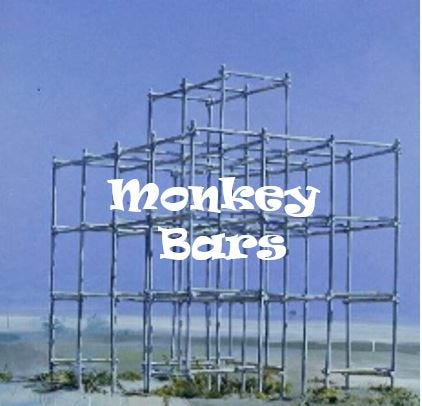Monkey Bars
“What do they want: smart kids or fast cars? They can’t have both!” I heard a Higher-up actually say this in a board meeting! I also regretted having learned from my father (who had a mental breakdown in his fifties) how to (and not to) siphon gasoline by sucking on a tube. — ‘An Einganeer’s Tale’, page 38.
When I was a kid, my favorite playground apparatus was the Monkey Bars. Oh, the challenge, and the sense of achievement when I reached the top. Sure, I fell a few times. And sometimes I’d chicken out and climbed back down. But I’d always find the nerve to get back on them again and pull myself up, one rung at a time.
You don’t see Monkey Bars much anymore. They have been deemed unsafe. The closest thing you see now-a-days are the crawl-through structures at some McDonald’s — with pads and nets and tubes. Kids still reach the top, but the sense of achievement is missing. Crawling achieves nothing. Pulling, hanging, stretching, swinging, jumping, slipping and almost falling does.
Risk and safety are inversely related. More safety means less risk, and greater risk is less safe. So what’s the balance? Over the past 50+ years, the balance has clearly tilted from riskier to safer. Many would say that this is a good thing, and just shows how ignorant we were of the dangers our children’s actions could bring back then. Which is true! But I believe an unexpected consequence of this tilt towards safety has been to stifled the potential of later generations.
Okay, our unhelmeted “Look Ma, No Hands” actions were foolish, but by God, we did them, and we knew we could. The confidence we had in ourselves grew, as did the knowledge we gained in challenging our limitations.
Carrying these experiences into later life has enabled us to better embrace calculated risks and make better decisions. They have led us to be more willing to confront challenges, experiment with new strategies, and explore opportunities that may entail unpredictability or potential drawbacks. I contend that we have become better innovators and entrepreneurs; independent thinkers who do not depend on governments or other people for their success.
Those who have been raised in safer environments are more inclined to take less chances, avoid possible disruptions, and opt for strategies and choices that minimize potential negative consequences. They are also quick to blame others or government for their own failures. Many still understand that taking a risk is required to achieve success, so they “decide” to take a chance. But since they lack an inbred knowledge of risk, the chance they take is more like gambling, and its outcome truly “left to chance.” Those with an innate knowledge of risk instead “decide” a course of action, consistent with their life experiences.
Abraham Maslow, a well known twentieth century American psychologist, is quoted as saying, “You will either step forward into growth, or you will step back into safety.” He is also known for defining his famous five step “Hierarchy of Needs”. Steps one and two are basic needs (food, shelter, safety). Steps three through five require putting yourself out there and taking risks, to achieve love, belonging, esteem, and self-actualization. Those who have not developed a true sense of risk through life experiences will find themselves constantly stepping “back into safety.”
Maslow died in 1970, before the dawn of video games and social media. So he did not know that kids would soon learn how to virtually experience Steps three through five, while never leaving the safety of Step two, and never taking a real risk. It is scary to think how kids have carried these experiences into later life.
Our church recently removed its playground equipment because the cost of upgrading it to today’s safety standards was ridiculous. Thank God our kids still have trees to climb, and fall out of, and learn from.


